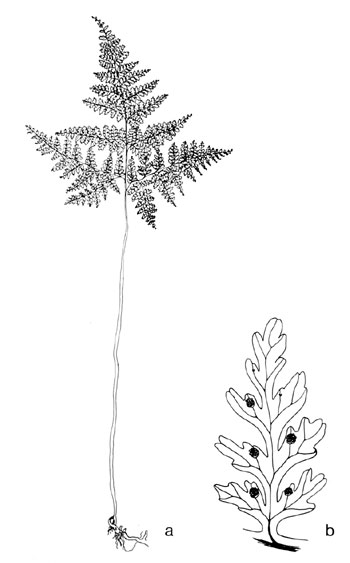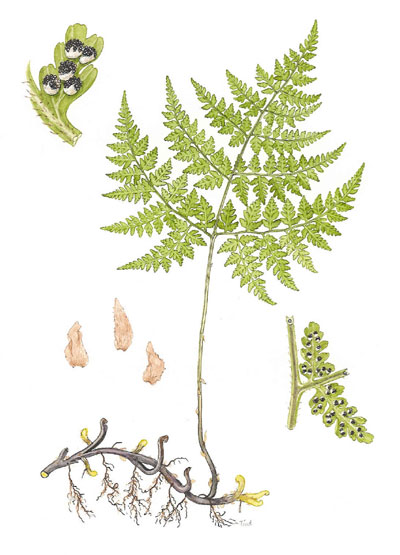|
Hardy Fern Home C. montana resources
All Ferns � Woodsiaceae �� Cystopteris
�Other Genera
|
| Cystopteris montana | ||
Mountain bladder fern | ||
|
Etymology
Montana is the word for the mountains.
Description
Rhizome: long-creeping, cordlike, internodes 1--2 cm, whitish at tip, scales usually tan to light brown, ovate-lanceolate.
Frond: 40 cm high by 15 cm wide, deciduous, monomorphic, blade/stipe ratio: 1:3 to 1:1. Stipe: dark brown to black at base, gradually becoming green or straw-colored above, sparsely scaly throughout, vascular bundles: 2, round or oblong. Blade: 3-pinnate-pinnatifid or more, equilaterally triangular, similar to a Gymnocarpium in form, firm, translucent, pale green, rachis and costae with tan, multicellular gland-tipped hairs. Pinnae: 7 to 8 pair, anadromous, pinnae often bending and/or curving towards the tip of the frond; pinnules lower innermost pinnule of the lowest pinnae large, resembling perhaps the third pinna above; costae grooves above continuous from rachis to costae; margins serrate; veins free, simple or forked, directed to notches. Sori: round, in 1 row between midrib and margin, indusium: ovate, transparent, beneath sorus on midrib side, sporangia: black, maturity: midsummer to late summer. Dimensionality: just above the basal pinna pair, the rachis curves over to hold the blade horizontally. Culture
Habitat: calcareous wet woods or along water courses, or in subalpine-arctic Salix communities.
Distribution: boreal or subalpine Northern Hemisphere, never abundant.
Hardy to -40�C, USDA Zone 2, requires a cool summer.
Distinctive Characteristics
Elegant is a term that pops up in many descriptions. Certainly very lacy, evocative of Gymnocarpium in blade form and horizontal position. The only not-very-nice thing about it is the poisonous hydrocyannic acid emitted by bruised fronds. Perhaps not in cultivation, but impossible to omit.
Synonyms
Polypodium montanum Lamarck |
|
|
Notes
Compare to There are a number of thrice+ divided, small ferns, but all are of a clumping habit. Gymnocarpium species are not quite as divided, but do possess the running habit and dimensionality of this plant; Gymnocarpium, however, has black stipes, lacks indusia.
Compare to There are a number of thrice+ divided, small ferns, but all are of a clumping habit. Gymnocarpium species are not quite as divided, but do possess the running habit and dimensionality of this plant; Gymnocarpium, however, has black stipes, lacks indusia.

Cystopteris montana. a) frond, highly dissected; b) fertile pinnule or segment with veins ending in the notches. �Illustration by V. Fulford from Ferns and Fern Allies of Canada, William J. Cody and Donald M. Britton, 1989, � Agriculture Canada, used with permission. |
